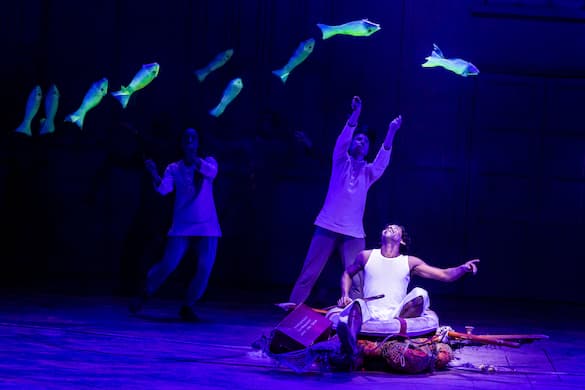‘Life of Pi’ Sails Onto Broadway After Shining Across the Pond
Director Max Webster and his team have risen to the occasion, lending vivid theatricality to a story that is, at its core, about faith and belief.

The hardest I have ever cried in a Broadway theater was while watching “War Horse,” an adaptation of Michael Morpurgo’s World War I novel that arrived at Lincoln Center a dozen years ago, after earning acclaim in London. The play is both a historical drama and a love story between a teenage boy and his horse; the latter was represented on stage through the magic of puppetry, with the animal and other equines brought to radiant, eventually wrenching life by brilliant designers and performers.
“Life of Pi,” which just opened at the Gerald Schoenfeld Theatre, is also based on a novel, the Man Booker Prize-winning bestseller by Yann Martel, in which a lad under duress finds connection outside his species; and the play also sails into New York after finding success across the pond. Aquatic metaphors are suitable here, as the ordeal faced by the play’s young protagonist unfolds on the open seas, and puppets are again involved, enhancing both the grandeur and the poignance of this production.
Director Max Webster and the playwright who adapted “Pi” for the stage, Lolita Chakrabarti, aren’t the first to draw inspiration from Mr. Martel’s novel. Ang Lee won an Academy Award for his direction of a 2012 film with a screenplay by David Magee, which earned additional Oscars for its vivid cinematography and visual effects and original score.
The movie isn’t mentioned in the play’s credits; Ms. Chakrabarti uses a different structure while incorporating a few of her own tweaks, and live theater obviously requires a different approach than the one Mr. Lee and his collaborators used to stunning effect. Mr. Webster and his team, which includes puppet designers Nick Barnes and Finn Caldwell, last represented on Broadway in 2018’s gorgeous revival of “Angels in America,” have risen to the occasion, lending vivid theatricality to a story that is, at its core, about faith and belief.
We first meet Pi, a moniker our young hero has chosen after being teased for his given name, in a hospital at Tomatlán, Mexico, as he’s recovering after a shipwreck that led to the deaths of everyone else on board, with one possible exception. Fleeing political unrest under Prime Minister Gandhi in the mid-1970s, Pi had been traveling with his family to Canada from Pondicherry in their native India, where his father ran a zoo.
In scenes set in Pondicherry, we get to know Pi as a precocious boy whose deep spiritual curiosity has led him to seek answers at the local mosque, Hindu temple, and Christian church. “I just love God, and they’re all next door to each other,” he explains to his befuddled parents, adding, “Aren’t they just versions of the same thing?”
Pi’s thirst for answers and his conviction in the existence of a higher power will be both challenged and affirmed by his harrowing experience on the Pacific Ocean. Hiran Abeysekera, reprising his Olivier Award-winning performance in the role, is equally adept at conveying the boy’s impishness, maturity, and anguish, while Tim Hatley’s scenery and Andrzej Goulding’s video design and animation evoke the terror and majesty of the natural forces that set against him, conjuring storms and flooding with convincing detail and transporting drama.
A central question in “Pi” is who, if anyone, accompanies our hero during his mind-boggling 227 days on a lifeboat. As fans of the novel and film know, no simple answer is offered, but the play’s second most prominent character is that of a Bengal tiger named Richard Parker, endowed with great expressivity by an expert team of puppeteers who represent various other creatures, some of whom are also shown struggling to survive.
If I wasn’t bawling by the end, as I was with “War Horse,” it’s perhaps because “Pi” ultimately says more about the destructive powers of nature than those of men. While the new play certainly nods to our darker instincts, and those of our fellow animals, it’s as unabashed a celebration of fortitude and, yes, faith as you’ll find on Broadway this season.

